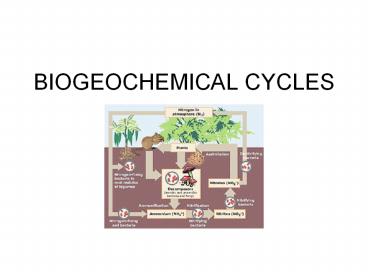BIOGEOCHEMICAL CYCLES - PowerPoint PPT Presentation
1 / 15
Title:
BIOGEOCHEMICAL CYCLES
Description:
BIOGEOCHEMICAL CYCLES The flow of energy in the biosphere is in one direction only: from the sun, through living organisms, into the environment, and out into space. – PowerPoint PPT presentation
Number of Views:409
Avg rating:3.0/5.0
Title: BIOGEOCHEMICAL CYCLES
1
BIOGEOCHEMICAL CYCLES
2
- The flow of energy in the biosphere is in one
direction only from the sun, through living
organisms, into the environment, and out into
space. - Matter cycles constantly from organism to
organism as well as to and from the environment,
which acts as a reservoir.
3
- The cyclic pathways taken by various elements in
passing through living organisms (biotic) and the
earth, its atmosphere and its bodies of water
(abiotic) are generally called biogeochemical
cycles. - The NITROGEN CYCLE is one of the most important.
4
- Proteins and nucleic acids are essential to life.
In order to make them, living things must obtain
nitrogen in a useable form. - Nitrogen in the air is diatomic (2-atom)
molecules N2, and no animal or plant can separate
them to use them. - To be useful the nitrogen must be fixedbe
attached to atoms of some other elements to form
a compound.
5
Nitrogen fixation..
- Can occur by
- Passage of UV light and lightning through the air
NO3- (nitrate ions) formed - Volcanoes, combustion of fossil fuels (coal, oil,
natural gas) and forest fires nitrate and NH3
(ammonia) - Rain brings the fixed nitrogen to the soil as
NH4- (ammonium ion)
6
- The bulk of this is carried out by
nitrogen-fixing bacteria in soil and by
cyanophytes (blue-green bacteria). - The most efficient nitrogen fixers are bacteria
found in nodules on the roots of certain plants,
notably the legumes (alfalfa, beans, peas,
lentils, clover). - Fertilizers also add nitrogen to the soil
7
- Animals must consume Nitrogen in the form of
already formed amino acids in their food. - Excretions of animals and the dead bodies of all
organisms are broken down in the soil by
decomposers in the process of ammonification ,
which produces ammonia.
8
- Nitrifying bacteria convert the ammonia to NO2-
(nitrite ion), then another group of nitrifying
bacteria convert the nitrite ion to NO3- (nitrate
ion). This is know as nitrification. - Nitrate is readily taken up by
- roots of plants and utilized.
9
- Denitrifying bacteria convert nitrate to N2O
(nitrous oxide) or N2 (nitrogen gas), which is
then lost to the atmosphere. - Nitrogen is lost from soil by erosion and carried
into streams, rivers, and ultimately the ocean. - It then cycles through aquatic organisms.
- Eventually, some nitrogen is lost to sediments at
the bottoms of oceans or lakes.
10
(No Transcript)
11
http//www.biology.ualberta.ca/facilities/multimed
ia/uploads/intro-biology/ncycle.swf
12
- Assignment
- 1)Diagram and label one of the Biogeochemical
Cycles. (pg371-374) - 2)Provide a caption under it explaining what is
occurring. - 3)Answer Section 4 Review (questions 1-8) on pg.
374.(due by end of class on Wed.. 9/8) - Finish your Energy Pyramid model first
13
(No Transcript)
14
(No Transcript)
15
(No Transcript)































